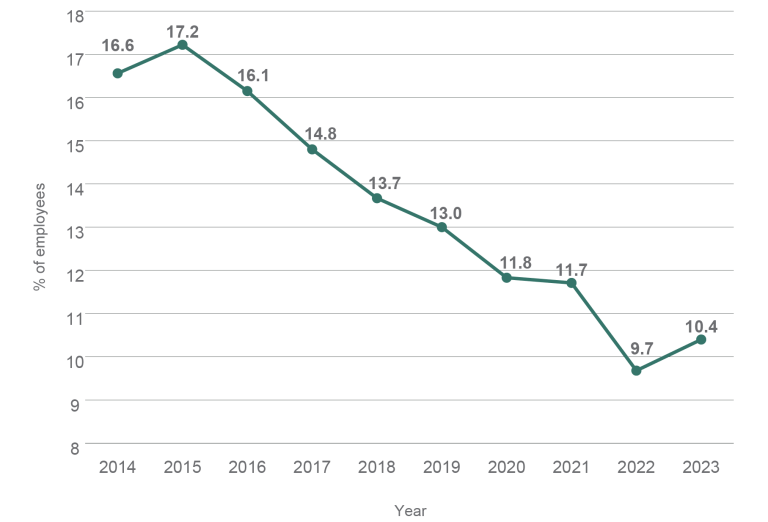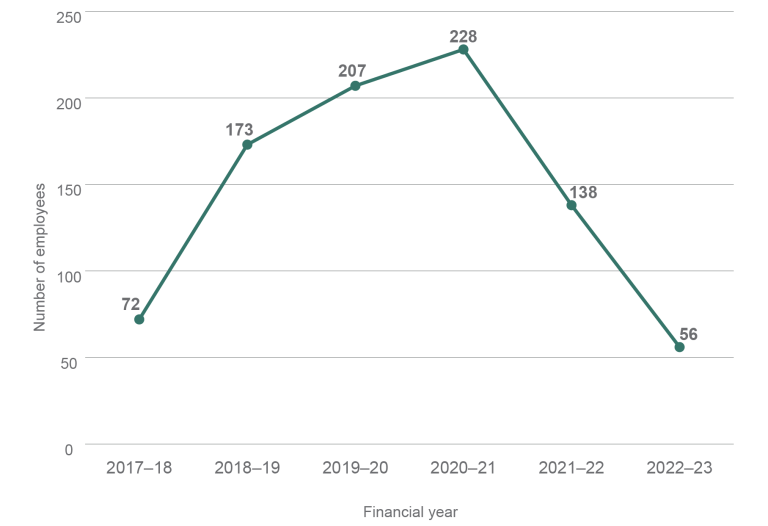Respectful and ethical workplaces

All Australian Public Service employees are required to behave in accordance with the APS Values and Code of Conduct, under the Public Sector Act 1999. The APS Employee Census and the APS Agency Survey provide indicators of how well the Values and Code of Conduct are being upheld across the service.
The APS Code of Conduct makes it clear that, in their workplace, all APS employees must treat everyone with respect and courtesy, and without harassment. In 2023, 10.4% of respondents to the APS Employee Census indicated they had been subjected to harassment or bullying in the workplace in the last 12 months. This is higher than the 9.7% in 2022. Figure 6.1 shows rates of perceived harassment or bullying in the APS over the past decade.
Reported rates of bullying and harassment are higher for some APS agencies. More information on perceived bullying and harassment rates within agencies is provided in the Agency benchmarking section of this report. From 2023, agencies are required to publish their APS Employee Census reports and action plans. The Australian Public Service Commission provides resources to support agencies in interpreting their employee feedback and identifying key issues for action.
The APSC and agencies analyse APS Employee Census results to understand the experiences of diverse groups within the APS workforce, including perceptions of behaviour such as bullying and harassment. This informs activities to ensure all APS workplaces are respectful for all employees.
Figure 6.1: Reported perceived rates of harassment or bullying (2014 to 2023)

Source: APS Employee Census
The APS Code of Conduct requires that all employees behave honestly and with integrity in connection with their APS employment. In 2022–23, agencies reported formal investigations into 62 employees for conduct that was categorised as corrupt. Of these, 56 employees were found to have breached the APS Code of Conduct (Figure 6.2) This is a reduction from 138 employees in 2021–22 and continues a downward trend from 2020–21.
Figure 6.2: Employees found to have breached the Code of Conduct for corrupt behaviour (2018 to 2023)

Source: APS Agency Survey
Support is provided by the APSC to agencies through services, learning resources, guidelines and face-to-face discussions on integrity matters. It also assists agencies to understand their obligations under the new Anti-Discrimination and Human Rights Legislation Amendment (Respect at Work) Act 2022.
The APSC’s Ethics Advisory Service provides information, policy advice and guidance to APS employees at all levels on the application of the APS Values and the Code of Conduct to promote ethical decision-making across the public service. In 2022–23, the Ethics Advisory Service received 400 enquiries – 137 from individual APS employees, and 139 from agency human resources areas and managers. The remaining 124 enquiries were from former employees, were anonymous, or out of scope.
APS agencies are collaborating on renewed APS-wide efforts to build and maintain a pro-integrity culture in the APS, responding to the findings of recent inquiries including the Royal Commission into the Robodebt Scheme.
See also
Agency benchmarking – Harassment and bullying, State of the Service Report 2022–23.
Appendix 2 – State of the service additional data, State of the Service Report 2022–23.



